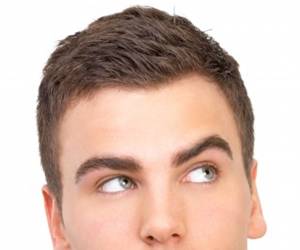Pimples are a common disorder of the skin that can occur almost anywhere on the face or body.
Pimples on scalp can be folliculitis, caused by bacteria in the follicles causing infection. If you have hair on your head, it is easy to damage these pimples when combing or brushing your hair and if you do not have hair on your head, they can become an embarrassment as well as being very uncomfortable.
Follow our advice to get rid of this problem, fast!
What Causes Pimples on the Scalp?

The reason that pimples develop on the scalp is almost always the same as with those that occur elsewhere, blocked pores.
Pores become blocked with dead skin cells and sebum and this provides a breeding ground for the acne bacteria that cause inflammation and irritation.
Scalp acne can also be triggered by sweating after exercise or shaving your head.
Prevention of Scalp Pimples

Keeping in mind the causes of pimples, maintaining proper hygiene is of paramount importance. Using a shampoo or treatment product containing salicylic acid (which is an acne medication that is also found in many medicated and anti-dandruff shampoos), will gently exfoliate your scalp and lessen the likelihood of pores becoming blocked with dead skin cells. This also helps to reduce excess oil formation on the skin which will not only reduce pimples, but will also help with the inflammation on your scalp. It is also a good idea to minimize the use of conditioners or choose your conditioner very carefully as these do tend to clog the pores.
Neutrogena T/Sal Shampoo is an inexpensive salicylic acid shampoo and is available at a great price from Amazon (follow the link to visit the product page).
If you just have the occasional scalp pimple, you could use a salicylic acid toner on a cotton bud, followed by a dab of treatment cream applied in the same manner.
Tip:- Do not use products containing Benzoyl Peroxide on your scalp if you have hair on your head as it can bleach your hair!
Changing the diet may also contribute to lowering excess oil production on the skin of the face and scalp. Other preventive measures for pimples include taking plenty of water to keep the skin properly hydrated and to flush out toxin. Getting sufficient sleep and avoiding stress as much as possible will also help with all forms of acne.
In addition, make sure that you shower and wash your scalp after any strenuous activity that has caused you to perspire as sweat can block pores and make the problem worse.
How to Get Rid of Pimples That Form On Your Scalp
[weaver_youtube http://youtu.be/3rDlysfPknU percent=100 ratio=0.5625 center=1 rel=0 autoplay=0 https=0 privacy=0 {youtube options}]
Preventing scalp pimples from forming is always the best course of action and once existing blemishes have been treated and remedied, continuing to use a salicylic acid shampoo as mentioned above, will help with this.
These two simple tips will help clear your skin of pimples:
- By eating healthy, non-oily foods: Foods rich in antioxidants helps in the build up of the strength of cells, which will help to combat the harmful yeast and bacteria. Include fruits like apples, bananas, orange and pineapples in the diet. Stay away from oily foods, and especially junk foods, as these may contain preservatives that can cause additional health problems besides skin problems.
- Clean the skin: The dirt and pollutants cause obstructions over the pores of skin that allows bacterial contamination to populate. It is very important to regularly wash the face and scalp with non-allergic soap. Washing the face is required after you’ve been exercising or any sports activity, or returned from outdoors.
Other things that will help with scalp problems
Gentle Cleansing: Use mild cleanser once a day to clean the areas of face and scalp which are affected with pimples or skin acne. Scrubbing them off will actually make the condition worse. A better choice is to clean the affected area well with warm water.
Noncomedogenic Hair Products: Some products for skin and hair contain ingredients that can block the hair follicles leading to pustules and pimples. Check the labels on any product you are using on your scalp. If it does not say noncomedogenic on the label, stop using it and swap to a product that will not cause a problem. You should notice an improvement in your scalp pimples quite quickly if this is the cause. Making sure that all the products you use on your skin are noncomedogenic will certainly help prevent future outbreaks wherever they are troublesome
Avoid exposure to Sun: Exposure to sun can further irritate the skin suffering from acne. When outside on a sunny day, wearing a hat or scarf helps to keep off the glare.
Use these home remedies: Apply tea tree oil to individual spots as an alternative to a salicylic acid product. Make a tea of peppermint leaves and apply this, (cooled) to your scalp and hair and leave on for several minutes before rinsing off. Rosewater can also be used in the same way.
Pimples on scalp can become severe and if this is the case for you, you may need to consult your Doctor or Dermatologist as antibiotics may be needed to clear up an underlying infection or steroid creams might be required to help with inflammation. For a simple and inexpensive first step for treating this type of pimple outbreak, try using T Gel Shampoo with Salicylic acid (pictured above). Or look for a product that contains Zinc pyrithione (such as Proactiv Soothing Scalp Treatment) which is extremely effective at treating dandruff (the dead skin cells that block the pores are what causes the problem).